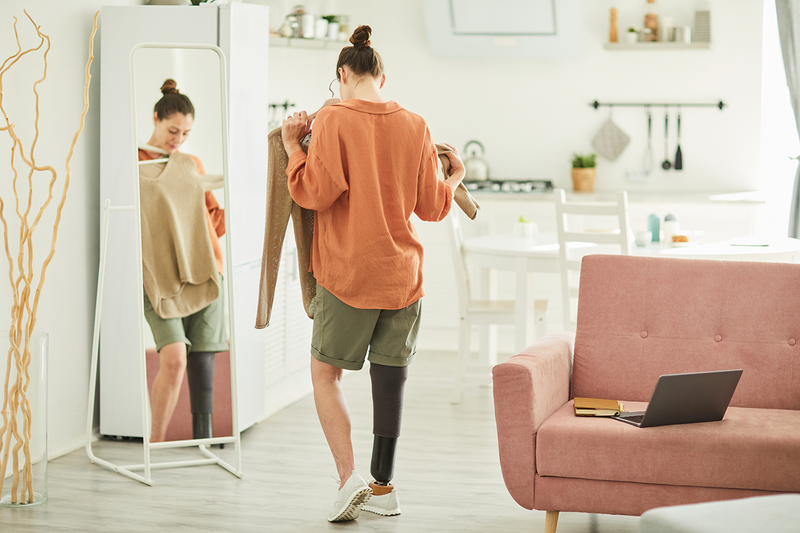
Adaptive Fashion and Why Inclusive Fashion Matters
Spring is a time for renewal, fresh colors, lighter fabrics and saying goodbye to the layers of winter! But for people with disabilities, fashion is not just about style, but about functionality, comfort, and accessibility. Traditional clothing can sometimes come with barriers, making it difficult or even impossible for some to dress independently and comfortably.
Adaptive clothing is designed with accessibility in mind, providing solutions for people with disabilities, including mobility limitations, sensory disabilities and other disabilities. While the Americans with Disabilities Act (ADA) mandates accessibility in public spaces, workspaces, and digital platforms, it does not explicitly regulate the fashion industry. However, the principles of the ADA (including ensuring equal access and preventing discrimination) may be extended to promote adaptive clothing.
How Adaptive Clothing Helps People with Disabilities
You may have come across adaptive fashion features without even realizing them. If you are a parent, you may have experience with baby onesies with snap closures along the sides, to make it easier to dress a young child. The similar side openings in adult clothing serve the same purpose for people with mobility challenges. Or, perhaps slip-on shoes, which are popular for convenience but a key adaptive feature for people who have difficulty tying laces.
Even elastic waistbands, which are marketed for comfort, provide essential accessibility for those who may have dexterity limitations. Many of these small design elements are integrated into mainstream fashion without being labeled as adaptive, but showing how inclusive design can benefit all.
Limited Mobility
For people with mobility disabilities, like wheelchair users or those with arthritis, dressing can be physically exhausting and frustrating. I have seen first-hand with my mom how difficult it can be to slip on a shirt when she is experiencing a flare up.
Adaptive clothing can remove these barriers by offering options such as:
- Open-back tops or jackets: Tops are designed to open from the back, allowing caregivers to dress people without having them raise their arms.
- Side-zipping or elastic waist pants: Pants are designed with side openings, making dressing easier for people who might struggle with bending.
- Magnetic closures instead of buttons: This can be ideal for people who have arthritis, stroke survivors, or those with limited hand dexterity. It can be especially helpful for little ones that have difficulty with fine motor skills.
Sensory Sensitivities
For people with Autism Spectrum Disorder (ASD) or Sensory Processing Disorder (SPD), certain kinds of fabrics, seams, and tags can be overwhelming or painful. Adaptive fashion offers:
- Tagless, seamless clothing that provides tag-free and ultra-soft garments to reduce irritation. As a mom to a toddler with autism who has sensory sensitivities, these have been lifesaving! No more cutting tags that leave stiff and irritating threads behind.
- Compression clothing can be helpful for sensory regulation in individuals with autism, who find deep-pressure stimulation calming.
- On the other hand, loose, breathable fabrics like cotton and bamboo-based clothing can help prevent sensory overload from rougher textures.
Prosthetics and Medical Devices
For people who use prosthetics, feeding tubes, catheters, or colostomy bags, finding clothing that accommodates their medical needs without discomfort is important. Adaptive fashion can assist with:
- Hidden openings for medical ports and feeding tubes.
- High waisted and adjustable clothing for ostomy bag users. These can provide comfort and security.
- Roomier sleeves and pant legs for prosthetics allow for wider leg openings for those with prosthetic limbs.
Neurological Disabilities
People who may have paralysis or weakness on one side of the body, cerebral palsy, or Parkinson’s disease, often have a hard time with fine motor skills and coordination. Adaptive fashion can assist with:
- One-handed dressing solutions like shirts with hook and loop closures and pull-on pants.
- Slip-on shoes with hands-free designs that don’t require tying laces.
- Anti-slip socks and shoes can prevent falls and provide stability for those with balance difficulties.
The ADA and Fashion: Why Accessibility in Clothing Matters
The ADA protects against discrimination in employment, public spaces, and digital access, however, there is not a direct link regulating the fashion industry. A lack of access to adaptive clothing can still create barriers for people with disabilities. It can add unnecessary challenges, limit a person’s independence, and participation in social activities. Clothing should not be a barrier to daily life. Adaptive fashion plays an important role in ensuring that people with disabilities can dress comfortably, independently and in a way that allows them to express their personal style.
Inclusion in fashion also extends to the retail experience, where people with disabilities sometimes face obstacles. These can include inaccessible fitting rooms, narrow aisles, and limited availability of adaptive clothing. As more brands continue to recognize the importance of adaptive fashion, my hope is that the industry will come to embrace accessibility and be fully inclusive.
Conclusion
By integrating adaptive fashion into mainstream offerings, we are a step closer to fulfilling the ADA’s mission of equal access and non-discrimination. Expanding adaptive fashion lines, improving retail accessibility, and increasing representation of people with disabilities in the industry are all steps towards a more inclusive world. This is a place where people have the same opportunities to express themselves through fashion.
Adaptive Clothing Brands
Here are some adaptive clothing brands that are paving the way in adaptive fashion:
- JuneAdaptive.com | Empowering People Through Clothes. | June Adaptive
- Buck & Buck Adaptive Clothing for Seniors, Disabled & Elderly Care
- Adaptive Clothing for Seniors & Elderly | Joe & Bella
- Adaptive Clothing for Seniors, Elderly & Disabled - Silverts
- Adaptive Clothing | IZ Adaptive
- BILLY Footwear | Fashion and Function For All
- Kids’ Adaptive Clothing : Target
- Tommy Adaptive | Tommy Hilfiger
- Adaptive at Seven7 Jeans
- Zappos Adaptive | Zappos.com
- Sensory Friendly Clothing | Autism & Adaptive Clothing | · Sense-ational You